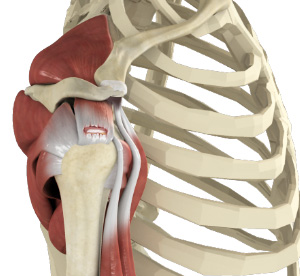Rotator Cuff Tear

Rotator cuff is the group of tendons in the shoulder joint providing support and enabling wider range of motion. Major injury to these tendons may result in tear of these tendons and the condition is called a rotator cuff tear. It is one of the most common causes of shoulder pain in middle aged adults and older individuals.
Causes
Rotator cuff tears result from impairment of the rotator cuff on part of the shoulder blade (scapula) as the arm is lifted. It may occur with repeated use of arm for overhead activities, while playing sports or during motor accidents. Tears of the rotator cuff can also occur from a fall or heavy lifting.
Symptoms
Rotator cuff tears often cause severe pain, weakness of the arm, and crackling sensation on moving shoulder in certain positions. There may be stiffness, swelling, loss of movements, and tenderness in the front of the shoulder.
Diagnosis
A Rotator Cuff Tear diagnosis is based on the physical examination, X-rays, and imaging studies, such as MRI. Rotator cuff tears are best viewed on magnetic resonance imaging (MRI).
Conservative Treatment Options
- Rest
- Shoulder sling
- Non-steroidal anti-inflammatory medication if Professor Bain agrees you are not at a high risk of complication, injection of a steroid (cortisone) and a local anaesthetic in the subacromial space of the affected shoulder to help decrease the inflammation and pain
- Certain Exercises
Surgery
Rotator cuff repair may be performed by open surgery or arthroscopic procedure. In arthroscopy procedure space for rotator cuff tendons will be increased and the cuff tear is repaired using suture anchors. These anchor sutures help in attaching the tendons to the humerus bone. Following the surgery, recovery is slow, a sling is required and you may be advised to practice motion and strengthening exercises.


